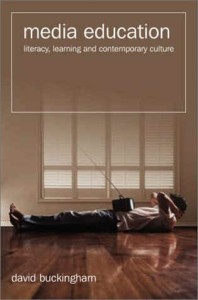
Of course, these changes are often overstated. Yet it cannot be denied that the experience of young people growing up in the contemporary media environment is now vastly different from that of the majority of their teachers. This in turn inevitably complicates the task of media educators. It places significant limits on what we can possibly know, and on how relevant our teaching can be. In place of the accessible ‘common culture’ of broadcast television, young people are now faced with a vast proliferation of media options, many of which may be unavailable – or at least incomprehensible – to us. We can no longer assume that our students will be sharing similar experiences with each other, let alone that they might do so with us. And we can no longer trust in a simplistic account of ‘identity politics’, in which media images are seen to have singular and predictable consequences in terms of our students’ perceptions of their place in the world.
While media teachers clearly do need to keep pace with the enthusiasms of their students, they cannot hope to know more than they do – nor should they. Indeed, in my experience, personal preferences and investments in aspects of media can easily be a liability in the classroom: students are very likely to reject what you enjoy, particularly if you make that clear to them. Yet the ‘generation gap’ between teachers and students is not simply a matter of taste. It may also have much more far-reaching implications in terms of the theoretical assumptions that inform our teaching.
A good example of this is in teaching about representation. In an interesting reflection on her own teaching, Elizabeth Funge … draws attention to the gap between her students’ perceptions of gender in the media and the feminist theories on which much media education is based. She argues that ‘1970s feminism’, with its emphasis on ideological deconstruction, simply fails to connect with contemporary gender politics – as embodied, for example, in the notion of ‘girl power’. Analysing ‘stereotypes’ and the ‘oppressive’ objectification of the female body does not help us to understand the appeal of the Spice Girls or Lara Croft; nor, Funge argues, does it connect with her female students’ ‘insistent and quite powerful expression of their own sexuality’. These arguments might be extended by considering more recent representations of female sexuality – Buffy the Vampire Slayer, Xena, Warrior Princess or Sex in the City, perhaps – that seem to combine a heightened form of ‘objectification’ of the body with a powerful celebration of agency.
The implication here is not just that media educators need to engage with their students’ changing media experiences. It is also that they need to recognize how those experiences are fundamentally different from their own – and that those differences may well have broader theoretical implications. The argument is not just that the media themselves are different, but also that the ways in which young people engage with them – the modalities of interpretation and engagement and investment – are also fundamentally changed. Funge argues that we are now in ‘a new phase of representation’, in which multiple readings and ambivalent reactions to media may be the norm. In this ‘postmodern’ context, she suggests, we need to recognize that media representations are more complex, and audiences more sophisticated, than was the case in earlier times. Contemporary representations of gender cannot be encompassed by outdated notions of ‘stereotyping’, ‘negative images’ and the ‘male gaze’ – although it is precisely these kinds of idea which, she argues, continue to circulate in media education. …
There have been very significant shifts in the social position and experience of women over the past few decades, and it would be surprising if these were not reflected in media representations. Yet whether similar arguments might apply to ‘race’ and ethnicity, for example, is more questionable. Some commentators have certainly been inclined to celebrate what they see as the emergence of ‘powerful’ non-white personalities and characters, and more hybrid ‘new ethnicities’, in the media; but the continuing presence of racist rhetoric and assumptions is hard to ignore. Yet here again, the implications of this in terms of ‘identity politics’ – and for education – are unlikely to be straightforward.
Phil Cohen … offers some useful reflections on these issues in his account of teaching about ‘race’ in the context of arts education. Cohen firmly rejects simplistic notions of ‘positive images’, arguing that they are based on a rationalistic approach, which regards racism as merely a result of irrationality or misinformation. Like Funge, he argues that images can be read in diverse and sometimes contradictory ways; and that the meanings attached to a notion such as ‘race’ are inherently unstable. Cohen argues that a more constructive starting point would be to recognize the elements of ‘masquerade’ – parody, mimicry, playful juxtaposition – that characterize some contemporary youth cultures; and he suggests that these can be used by students to subvert essentialized ethnic identities, and to generate more complex narratives of the self. His example, an image of an ‘Indian Cowgirl Warrior’, created by an ethnically mixed group of seven- and eight-year-old girls, is a distinctly hybrid, ‘multicultural’ creation which also gives voice to their resistance to racial injustice.
Behind both the studies I have mentioned here lies a broader dissatisfaction with ‘modernist’ conceptions of meaning and identity. They explicitly contest ‘politically correct’ teaching, which seeks to provide a form of ‘counter-propaganda’ to what is seen as the ideological delusions promoted by the mainstream media. They also imply that identity itself cannot be seen in singular terms, as something fixed or essential. They therefore suggest that prescriptive teaching strategies that try to legislate fixed meanings and impose ‘correct’ thoughts may miss much of the positive political potential of students’ media cultures.
Buckingham, David. 2003. Media Education: Literacy, Learning and Contemporary Culture. Cambridge UK: Polity Press, pp.158-161. || Amazon || WorldCat
